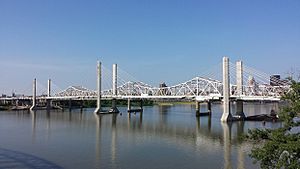Abraham Lincoln Bridge facts for kids
Quick facts for kids Abraham Lincoln Bridge |
|
|---|---|

The Abraham Lincoln Bridge viewed from
the Big Four Bridge, with the parallel John F. Kennedy Memorial Bridge in the background |
|
| Coordinates | 38°15′52″N 85°44′37″W / 38.26444°N 85.74361°W |
| Carries | 6 lanes of northbound |
| Crosses | Ohio River |
| Locale | Louisville, Kentucky and Jeffersonville, Indiana |
| Characteristics | |
| Design | Cable-stayed bridge |
| Total length | 2,100 ft (640 m) |
| Longest span | 700 ft (213 m) × 2 spans |
| History | |
| Opened | December 6, 2015 |
| Statistics | |
| Toll | $2.10 (with EZ-Pass/RiverLink transponder) $1.05 frequent user (applies to all trips in calendar month with 40+ trips) $3.16 (with Pay-By-Plate account) $4.20 (Pay-By-Plate with no account) |
The Abraham Lincoln Bridge is a large, modern bridge that helps cars travel across the Ohio River. It connects the cities of Louisville, Kentucky, and Jeffersonville, Indiana. This bridge has six lanes for northbound traffic on Interstate 65. It is a cable-stayed bridge, which means its deck is supported by strong cables connected to tall towers.
The main part of the bridge stretches 700 feet (213 meters) across the river. The total length of the bridge is 2,100 feet (640 meters). It is named after Abraham Lincoln, a famous U.S. President who was born in Kentucky and grew up nearby in Indiana.
Contents
Building the Bridge
The Abraham Lincoln Bridge officially opened on December 6, 2015. It was built right next to the John F. Kennedy Memorial Bridge, which is a bit older. The Lincoln Bridge was designed to carry six lanes of northbound traffic on I-65.
Originally, there were plans to include paths for people walking and biking. However, these plans were later removed from the project. The older Kennedy Bridge, which was finished in 1963, was updated to carry six lanes of southbound traffic.
How Traffic Flow Changed
When the Lincoln Bridge first opened, it carried three lanes of traffic in both directions for a few months. On October 10, 2016, five lanes of the Kennedy Bridge reopened after its upgrades. At that point, the Lincoln Bridge began carrying only northbound traffic.
By December 2016, both bridges were fully open. This meant there were six lanes for traffic going north and six lanes for traffic going south.
Public Input on Design
When the bridge was being designed, people living in Louisville and Jeffersonville got to share their ideas. From 2005 to 2006, hundreds of citizens attended meetings. They looked at different bridge designs using 3D computer models.
This process helped designers understand what the public liked best. The public's opinions helped choose the final look of the bridge.
Final Design and Cost
On July 19, 2006, the final design options for the bridge were announced. These included different styles, like a three-span arch or a cable-stayed design with various tower shapes. The estimated cost for building the bridge was about $203 million.
Other Bridges in Louisville
The Abraham Lincoln Bridge is one of several bridges in downtown Louisville. Other important bridges include:
- The John F. Kennedy Memorial Bridge: Built between 1961 and 1963.
- The George Rogers Clark Memorial Bridge: Constructed from 1928 to 1929, it has four lanes.
- The Big Four Bridge: This bridge was originally for trains from 1895 to 1969. It reopened in May 2014 as a popular bridge for pedestrians and cyclists.
Tolls and Usage
To help pay for the bridge, drivers have to pay a toll to cross it. Tolling on both the Lincoln and Kennedy bridges began on December 30, 2016. You can pay with an electronic device called a transponder (like EZ-Pass/RiverLink) or through a Pay-By-Plate system.
Some people have criticized the bridge because they believe it is not used enough. They say that many drivers avoid the bridge to avoid paying the toll. Some of the original planners for the bridge also did not want to use tolls. They preferred not to have electronic payment systems without actual toll booths.

